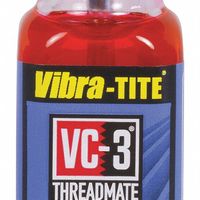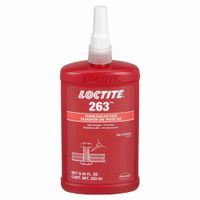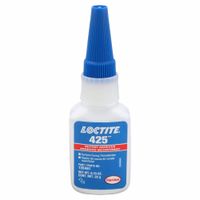Call +(254) 703 030 000 / 751 483 999 / 721 704 777
- Home
- Adhesives Sealants And Tape
- Threadlockers Retaining Compounds
.....Read More
Frequently Asked Questions
What is the difference between threadlockers and retaining compounds?
Threadlockers and retaining compounds are both anaerobic adhesives, meaning they cure in the absence of air and in contact with metal ions. However, their primary applications and characteristics differ significantly.
Threadlockers are designed to prevent the loosening of threaded fasteners due to vibration, thermal expansion, and corrosion. They come in various strengths (low, medium, high) to allow for different degrees of disassembly. Low-strength threadlockers are suitable for small screws that may need frequent adjustment, while high-strength versions are for permanent assemblies where disassembly is unlikely. They fill the microscopic gaps between the threads, creating a solid, vibration-resistant bond that also seals against leaks and corrosion.
Retaining compounds, on the other hand, are specifically formulated to secure cylindrical assemblies, such as bearings, bushings, and shafts, without the need for press fits, keyways, or splines. They provide 100% surface-to-surface contact, eliminating corrosion and wear that can occur with traditional mechanical methods. This allows for looser machining tolerances, reducing manufacturing costs. Retaining compounds offer very high shear strength, ensuring that components remain fixed even under extreme stress and vibration. Unlike threadlockers, they are not typically used on threaded parts, as their higher strength would make disassembly extremely difficult or impossible without specialized tools or heat.
In summary, while both products enhance mechanical assembly, threadlockers are for securing threaded fasteners with varying degrees of permanence, and retaining compounds are for creating strong, permanent bonds between cylindrical components to prevent movement and wear.
How do anaerobic threadlockers work?
Anaerobic threadlockers are adhesives that cure in the absence of air (anaerobic) and in the presence of metal ions, typically from the metal surfaces of threaded fasteners. When applied to fasteners, the liquid threadlocker fills the gaps between the threads. As the parts are assembled, air is excluded, and the metal surfaces catalyze the polymerization of the adhesive. This curing process forms a tough, cross-linked plastic that locks the threads together, preventing loosening due to vibration, thermal expansion, or shock. The cured threadlocker also seals the threads, preventing corrosion and leakage. Different grades of anaerobic threadlockers offer varying levels of strength, allowing for easy disassembly (low strength), or permanent locking (high strength).
Can threadlockers be used on plastic fasteners?
Threadlockers are generally not recommended for use on plastic fasteners or components. Most threadlockers are designed to cure in the absence of air and in the presence of active metal ions, which are found in metal fasteners. Plastics, however, typically do not have the same surface chemistry or catalytic properties to initiate the proper curing process of threadlockers.
Furthermore, some threadlockers contain solvents or chemicals that can be incompatible with certain types of plastics, potentially causing degradation, stress cracking, or weakening of the plastic material over time. This can lead to fastener failure and compromised joint integrity.
If a fastening solution is needed for plastic components, it's usually better to consider alternatives specifically designed for plastics, such as plastic-compatible adhesives, self-tapping screws designed for plastics, or mechanical fasteners that do not rely on chemical adhesion to the plastic itself. Always consult the threadlocker manufacturer's technical data sheet for compatibility information with specific materials.
What are the benefits of using retaining compounds?
Retaining compounds are used to secure cylindrical parts within an assembly, preventing loosening, leakage, and corrosion. They offer several key benefits. Firstly, they provide a strong, unitized assembly, distributing stress evenly over the entire joint contact area, which can increase the fatigue life of the assembly compared to mechanical fastening methods. Secondly, retaining compounds fill microscopic gaps between mating parts, eliminating fretting corrosion, a common cause of part failure. Thirdly, they create a hermetic seal, preventing leakage of fluids or gases and protecting against corrosion from environmental factors. This also helps to prevent rust and other corrosive elements from compromising the integrity of the joint. Finally, retaining compounds allow for lighter, more compact designs as they can replace or supplement traditional mechanical fasteners like keys, splines, and press fits, reducing machining costs and assembly time. They are particularly useful for applications requiring high strength, durability, and resistance to vibration and shock.
How do you remove threadlocker from a fastener?
Removing threadlocker from a fastener typically involves applying heat to break down the chemical bond of the threadlocker. For most common threadlockers, heating the fastener to a temperature between 250°F (121°C) and 650°F (343°C) will soften the compound, allowing the fastener to be loosened with standard tools. A heat gun or propane torch can be used, but care should be taken to avoid overheating the surrounding materials, especially if they are sensitive to high temperatures. Once the threadlocker is softened, the fastener can usually be removed. After removal, any residue can often be cleaned off with a wire brush or a chemical solvent like acetone, brake cleaner, or a specialized threadlocker remover. Always ensure proper ventilation and follow safety precautions when using heat or chemical solvents.
Are there reusable threadlockers available?
Yes, there are reusable threadlockers available, though the term "reusable" needs some clarification in this context. Traditional liquid threadlockers (anaerobic adhesives) are designed for a single application and cure to form a strong bond, making the fastener difficult to remove without significant torque and sometimes heat. Once removed, the cured threadlocker would need to be cleaned off, and new threadlocker applied if the fastener is to be reinstalled.
However, some manufacturers offer pre-applied, dry-to-the-touch threadlocker coatings on fasteners. These often use microencapsulated adhesives that are crushed and activated when the fastener is installed. While these pre-applied coatings might offer some residual locking performance if the fastener is removed and reinstalled, their effectiveness typically diminishes significantly after the first use.
For truly "reusable" anti-loosening solutions, mechanical locking devices are more appropriate. These include: * **Lock Nuts:** Such as nylon insert lock nuts (nyloc nuts) or prevailing torque nuts, which create friction to resist loosening. The nylon insert can wear down over repeated uses, but they are generally more reusable than liquid threadlockers.
* **Lock Washers:** Like split lock washers, star washers, or Nord-Lock washers. Nord-Lock washers, in particular, use a wedge-locking action that can be very effective and allow for repeated installation and removal of the fastener without losing their locking capability.
* **Safety Wire:** A physical method where wire is threaded through drilled holes in fasteners to prevent them from rotating loose. This is a highly reliable and inherently "reusable" method in the sense that new wire can always be applied.In summary, while liquid threadlockers are generally not reusable in the traditional sense, pre-applied coatings offer limited reusability, and mechanical locking devices provide genuinely reusable solutions for preventing fastener loosening.
What is the best threadlocker for high-temperature applications?
For high-temperature applications, specific threadlockers are formulated to withstand extreme heat without losing their adhesive properties. The "best" choice often depends on the exact temperature range, the size of the fasteners, and whether disassembly might be required.
Generally, anaerobic threadlockers are common for industrial and automotive uses. For high temperatures, look for products specifically designed for such conditions, as standard threadlockers might degrade. For instance, some threadlockers can withstand continuous temperatures up to 230°C (450°F) or even higher for intermittent exposure.
Popular choices include those with a methacrylate ester base, often identified by names like "High-Temperature Threadlocker." These are engineered to prevent loosening from vibration and thermal expansion in demanding environments. Always consult the product's technical data sheet for precise temperature ratings and application guidelines.
How long does it take for threadlocker to cure?
Threadlocker cure times vary depending on the specific product, but generally involve an initial fixture time and a full cure time. Fixture time is when the threadlocker is strong enough to resist minor handling and typically ranges from a few minutes to an hour. Full cure, where the threadlocker reaches its maximum strength, can take 24 to 72 hours. Factors like temperature, humidity, and the type of material being bonded can influence these times. Always refer to the manufacturer's data sheet for the most accurate curing information for a particular threadlocker.
Can retaining compounds be used on non-metal parts?
Yes, certain retaining compounds can be used on non-metal parts, although their primary application is often with metal assemblies. The effectiveness depends heavily on the specific type of retaining compound and the nature of the non-metal material.
Many retaining compounds are anaerobic adhesives, meaning they cure in the absence of air and in the presence of metal ions. While this characteristic makes them ideal for metal-to-metal bonds, some formulations are designed to be "primerless" or "surface insensitive," allowing them to cure on less active surfaces, including some plastics and ceramics.
When considering retaining compounds for non-metal parts, it's crucial to ensure good surface preparation for optimal adhesion, which may include cleaning and roughening. Additionally, it's important to select a compound that is compatible with the specific non-metal material to prevent degradation or inadequate bonding. Always consult the manufacturer's technical data sheets for compatibility and application guidelines.
What are the common applications for threadlockers and retaining compounds?
Threadlockers and retaining compounds are anaerobic adhesives that cure in the absence of air when confined between close-fitting metal surfaces. They are primarily used to secure threaded fasteners and cylindrical assemblies, preventing loosening due to vibration, thermal expansion, and shock, and offering protection against corrosion.
Common applications for threadlockers include: * **Automotive:** Securing engine bolts, transmission components, suspension fasteners, and wheel studs.
* **Electronics:** Fastening small screws in circuit boards, sensors, and electronic devices.
* **Heavy Equipment:** Locking bolts in agricultural machinery, construction equipment, and mining vehicles.
* **Industrial Machinery:** Preventing loosening of bolts in pumps, motors, gearboxes, and robotics.
* **Marine:** Securing fasteners exposed to harsh environments, preventing rust and ensuring stability.
* **Aerospace:** Critical for securing components in aircraft engines, landing gear, and control systems.Retaining compounds are used for: * **Bearings:** Securing bearings onto shafts or into housings, eliminating the need for press fits, keys, or splines.
* **Bushings:** Bonding bushings into housings for a secure, vibration-resistant fit.
* **Sleeves:** Retaining sleeves in various mechanical assemblies.
* **Gears:** Mounting gears onto shafts, ensuring concentricity and preventing slippage.
* **Pulleys:** Securing pulleys to shafts, especially in high-speed or high-load applications.
* **Rotors:** Bonding rotors to motor shafts, improving torque transmission and reducing vibration.These adhesives provide a reliable and cost-effective alternative to traditional mechanical fastening methods, improving the durability and safety of assemblies across numerous industries.



